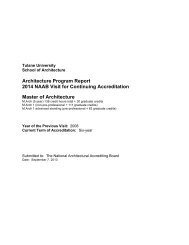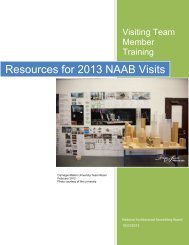Architecture Program Report Tulane University New Orleans ...
Architecture Program Report Tulane University New Orleans ...
Architecture Program Report Tulane University New Orleans ...
Create successful ePaper yourself
Turn your PDF publications into a flip-book with our unique Google optimized e-Paper software.
spatial principles, as well as the conception and development of interior<br />
and exterior spaces, building elements, and components is also attended<br />
to in the History/Theory sequence of the curriculum. This is particularly the<br />
case in the required History (AHST) courses, whereby special attention is<br />
paid to these concerns. It is significant and highly beneficial that the History<br />
faculty are in-residence within the School of <strong>Architecture</strong>; hence, history is<br />
not only taught as a progressive series of events, but attention is given to<br />
the “close-reading” of the buildings and urban spaces as material artifacts<br />
and working organisms. This reinforces the student’s understanding of the<br />
primacy of fundamental design skills not only in the development of their<br />
design studio work, but in the critical insight of precedents and their<br />
contexts.<br />
7. Collaborative Skills<br />
Ability to recognize the varied talent found in interdisciplinary design project<br />
teams in professional practice and work in collaboration with other students<br />
as members of a design team.<br />
Collaborative Skills development occurs across the design curriculum, in<br />
particular as students initiate studio projects. A first and second-year<br />
(DSGN 110, 120; DSGN 210, 220, AVSM 110, ADGM 120) focus on<br />
collaborative skills requires that students go through a period of developing<br />
studio models, research, and digital technology skills development in<br />
collaborative fashion. The apex of this basic skill is reached in the<br />
URBANbuild studios (DSGN 410, 420 micro and macroscale) of fourth year.<br />
In addition all students have the opportunity to develop and execute a<br />
hands-on building project during the course of their education. This also<br />
occurs during fourth-year and in some cases extends to the fifth-year<br />
thesis. These building projects tend to require collaborative efforts, both<br />
during the design and building phases.<br />
Collaborative learning also takes place in the extraordinary array of foreign<br />
study programs the school offers.<br />
While it is true that the usual methods of evaluation are more difficult to<br />
apply when assessing a group project, the pedagogical intention—that of<br />
the design and work collaboration—clearly supersedes the limitations of<br />
conventional grading. It is also true that, in some cases, the clarity of a<br />
conceptual approach is diluted, in other cases the amalgamation of insights<br />
and abilities leads to a much higher degree of resolution and greater depth<br />
in work productivity, a benefit that is reflected in the success of the final<br />
product.<br />
As the students are reminded, the use of collaborative associations in<br />
design and related fields is fundamental to the practice of architecture.<br />
This is particularly showcased in the RBST series of courses as well.<br />
Additional opportunities supportive of the cultivation of collaborative skills<br />
occur in several other areas of the elective curriculum, most notably in<br />
several the course for Studio in the Woods (DSGN 410/ACTS 332) and<br />
particularly in Preservation Studies (“Studio in Building Preservation –














